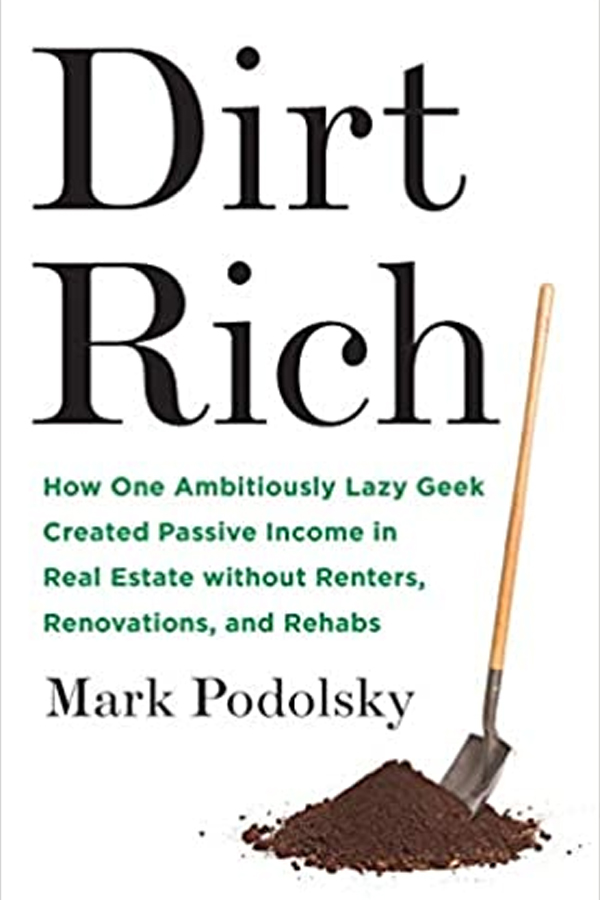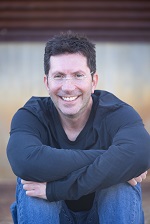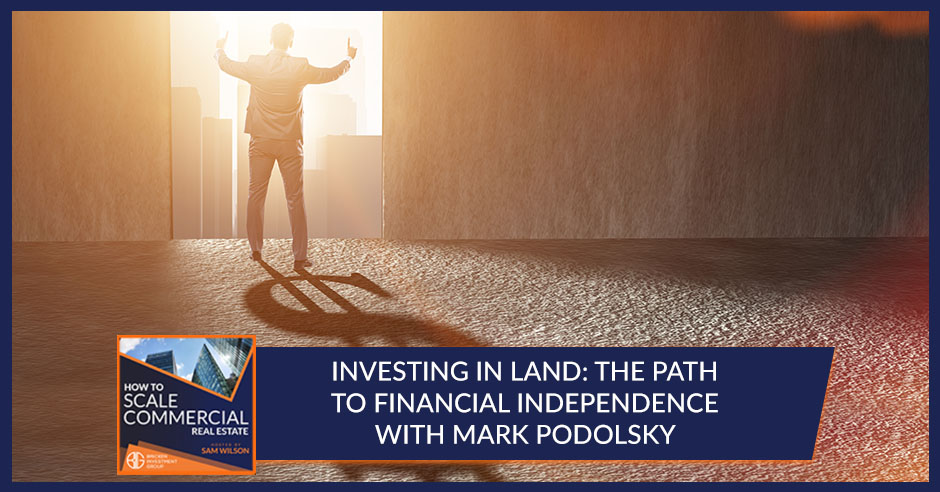Finding financial freedom isn’t easy. But if you face your fears and take them head on, then you can find the path. Mark Podolsky of Land Geek faced his fears, and by investing in land, is now well on his way to financial independence. In this episode, Mark is interviewed by Sam Wilson as he shares how he got into real estate and his journey so far. He also shares useful tips and strategies he used to great effect. Tune in and learn more about learning to become financially free through land.
—
Watch the episode here:
Listen to the podcast here:
Investing In Land: The Path To Financial Independence With Mark Podolsky
Mark Podolsky was armed with only $3,000, gut-wrenching fear and absolutely no real estate experience until he bought his first few parcels of raw land in 2001. He is the author of Dirt Rich, the ultimate guide to helping you build a passive income and owner of Frontier Properties, a very reputable and successful land investing company that has been buying and selling land full-time since that transaction in 2001. By focusing on working smart, not hard, he has completed over 5,500 land deals with an average ROI of over 300% on cash flips and over 1000% on the deals he sells with financing terms. Mark, welcome to the show.
Thanks so much for having me. It’s a pleasure to be here.
The pleasure’s mine. This is a fun topic. It’s not the blue ocean everybody might think it is but it’s certainly one that’s not that well understood especially not in the commercial environment, at least not for the guests that we have come on this show. Can you briefly tell us before we dig into the nuances of land investing, briefly, where did you start? Where are you now? How did you get there?

Let’s rewind the tape to 2000. I had a 45-minute commute to work and back. I was a miserable micromanaged investment banker specializing in private equity groups, with mergers and acquisitions. It got so bad for me. I wouldn’t get the Sunday blues anticipating Monday coming around. I’d get the Friday blues anticipating the weekend going by real fast and having to be back to work on Monday.
My firm hires this guy. He’s telling me that as a side hustle, he’s flipping raw land, pennies on the dollar and he’s making a 300% return on his investment. I’m looking at companies all day long, a great company that has 15% EBITDA margins or cashflow. The average is 10%. I’m looking at companies all day long with less than 10% so I don’t believe him. I got $3,000 saved up for car repairs.
I go to New Mexico with him. I do exactly what he tells me to do. I buy up ten half-acre parcels at an average price of $300 each. I flip them online. They all sell for an average price of $1,200 each. It worked. I took all that money and went to another auction in Arizona, which is where I live. Again, it’s 2000. There’s no one in the room. I’m buying up lots and acreage for nothing. For the following months, I sold all that land. I made over $90,000 in cash. I go to my wife, who’s pregnant. I say, “I’m going to quit my job and become a full-time land investor.” She said, “Absolutely not.” I said, “Okay.” It took about eighteen months for the land investing income to exceed the investment banking income and then I quit. I’ve been doing it full-time ever since and I love it.
There are so many questions that go into that. What’s it look like? How have things changed since 2000? Walk us through a typical deal. Why are people selling? I could ask questions all day long.
I’m going to walk you through the model. Essentially, when I started, I was dumb. I thought I was playing entrepreneur. What I built for myself was a better job. I got a mentor and he’s like, “Don’t call yourself an entrepreneur.” He’s like, “You’re insulting me.” I’m like, “What are you talking about?” He was like, “If you died tomorrow, what happens to your ‘land business.’” I’m like, “He’s like, ‘This thing needs to be able to run without you.’” Step by step, I started learning about delegating and automating software and I got myself out. I’m going to walk you through the model and you’ll see how I’ve got this 90% automated with software and inexpensive virtual assistance. Sam, where do you live?
Memphis, Tennessee.
I’m going to assume that you own ten acres of raw land in Texas and you owe $200 in back taxes. You’re basically advertising two important things to me. Number one, you have no emotional attachment to that raw land. You’re in Memphis. The property is in Texas. Number two, you’re distressed financially in some weird way because you’re not paying your property taxes. When we don’t pay for things, we don’t value them in the same way. As a result, the county treasury keeps sending you notices saying, “Sam, don’t pay your taxes.” You’re going to lose that property to attack the lien or tax deed investor.
All I’m going to do is look at the comparable sales on your ten-acre parcel. I’m going to take the lowest comparable sale, I’m going to divide by four and that’s going to get me what Warren Buffett would call a 300% margin of safety. Let’s say the lowest comp is $10,000 on your parcel. I’m going to send you an offer of $2,500 for your ten acres. You accept it because for you $2,500 is better than nothing. In reality, 3% to 5% of people accept my “top dollar offer.”
Now that you’ve accepted it, I’ve got to go through due diligence or in-depth research. I have to confirm you still own the property. I have to confirm back taxes are only $200. I have to make sure there have been no breaks in the chain of title. I have to make sure there are no liens or encumbrances. I want to know the GPS coordinates. I want to know everything a buyer’s going to want to know. I want to get the aerial maps, the plat maps and the GIS maps. What are the neighbors doing? What are the roads like? This whole checklist.
I’ll invest $11 in due diligence to my team in the Philippines that are connected to an American title company because it’s $5,000 or less. If it’s $5,000 or more, I’ll actually close through a title company. In this scenario, it’s $2,500. I’ll take a little bit of risk. Everything checks out. I buy the property from you for $2,500. I’m going to sell this property in 30 days or less and I make a cashflow like a rental home.
I’ve got a built-in best buyer. Do you know who it is? It’s the neighbors. I’m going to send out neighbor letters and say, “Here’s your opportunity to expand your privacy, expand your views and protect your views. Know your neighbor.” Oftentimes the neighbors will buy. If they pass, I’ll go to my buyers’ list. My buyers’ list passes, I go to a little website you may have never heard of called Craigslist. It’s the tenth most trafficked website in the United States.
I go to a smaller one. I know you’ve probably heard of this one called Facebook. I go to buy and sell groups in the Marketplace and then I’d go to the land sites. LandModo.com, LandAndFarm.com, LandsOfAmerica.com, LandFlip.com and LandHub.com. These are platforms where people buy and sell raw land. The magic in the way that I can sell this in 30 days or less is I’m going to make it irresistible to that next buyer. All I’m going to ask for, if you want to control this 10-acre parcel that Sam Wilson used to own, the famous Sam Wilson, all you have to do is put a $2,500 down payment, make a monthly payment of $249 a month at 9% interest for the next 84 months.
It’s a one-time sale. I’m going to get my money out on the down. I might go 6 to 10 months out and then I’ll make it a car payment. Let’s say $249 a month at 9% interest in the next 84 months. No renters, no rehabs, no renovations, no rodents and because I’m not dealing with a tenant, I’m exempt from Dodd-Frank, RESPA and the SAFE Act. The game we play is going to create enough of these landowners, where our passive income now exceeds our fixed expenses and we’re working because we want to, not because we have to.
That’s certainly compelling. How do you end up not buying a dog piece of property that no one wants?
I’ve done this over 6,000 times and I’ve never been stuck with a piece of property. What you call a dog piece of property, someone is going to call an amazing prepper parcel. These are people that are preparing for the worst and hoping for the best. There is literally a pig for every barn. I bought land that looks like Chernobyl. It all sells if it’s priced right.
I can think of places. You mentioned the state of Texas. There’s a lot of value in Texas especially in the commercial real estate space but in 2020, I ended up driving through the Northwest corner of Texas. I thought, “My gosh.” I’m not sure what road we were on but I go, “What is this place? This looks like the moon. I can’t imagine anybody who would want to buy this land if it were free,” but you’re telling me I’m wrong.
They want it.
That’s how the deal works. You’ve given us the playbook for how you dispose of the land and how you market the land. One thing we hadn’t talked about is how do you find it?
When we don’t pay for things, we don’t value them in the same way.
Let’s be honest. If somebody wakes up and thinks to themselves, “Let’s roll in on Iowa,” unless you live in Iowa. We’re going to focus on California, Nevada, Washington, Oregon, Arizona, Colorado, New Mexico, Texas, Florida, Southwest and a little bit Northwest. These are the sunshine states. These are fast-growing states and these states have a ton of inexpensive raw land. Let’s say that I moved to Memphis and you were the best investor I know. I’m going to follow where you buy. I’m going to look where other land investors are buying because I know definitively there’s a market there. That’s where we start.
How do you find out where other investors are buying?
We’re going to go back to those land sites. We’ll start at LandModo.com and we’ll see what counties are the other land investors marketing the properties in?
The business sounds too simple. I’ll be honest with you. From an outsider’s perspective that invests in self-storage, multifamily and some ground-up development stuff, this sounds really oversimplified. Am I missing something?
I prefer boring. It’s the most boring real estate model. It’s really simple in that sense. You’re not going to go on HGTV or the DIY Network and see Flip This Land. The before pictures are raw land. The after pictures are raw land. We shuffle paper and make money. I’ll give you that. It is simple in that sense especially compared to multimillion-dollar multifamily deals.
I do think it’s a good gateway drug to start building up cashflow and wealth and then go into multifamily. It’s not easy. There are a lot of moving parts and the way that we look at it, we look at it as a business. To do volume, you’re going to have to have a team in place. You’re going to have to use the software on the frontend and on the backend to do all this because the last thing you want to do is build yourself another job.
Everything you’ve mentioned in the post-purchase marketing steps, that’s a giant time-suck. Posting it on Land and Farm, doing this, getting on Craigslist and going to Facebook. I could imagine you could spend 2 to 4 hours monkeying around with getting all this stuff posted and the right information on each site. How do you create that system? That’s what your business coach told you.
Let’s say that I’m going to go ahead and post an ad on Facebook. The first thing I’m going to do is record myself posting an ad and I’m going to tell them why I’m posting this ad. Why you’re valuable so you don’t feel like you’re a cog in the machine. This is our why. This is our mission. This is why and how we’re going to post an ad and I’m recorded. I might use Flick.io or Zoom. It doesn’t matter but I want to record those steps. I’ll go to Fiverr.com and have a technical writer transcribe what I did and break it down. I’ll go to a ten-year-old child and say, “Can you explain this process to me?” If they get it, it’s a good process. If they don’t, back to the drawing board and do it again. You want to make it really simple because the process is more valuable than the person. The people are going to come and go.
Once I have my process, I going to hire three people and test them, “Go ahead, follow this process and post an ad on Facebook.” I’m going to give a test. I’m going to make a mistake in my process where I’m going to give them something impossible to do, an impossible task. Will they say it’s impossible or will they think for themselves and be like, “I couldn’t do what you asked but I did this instead and it solved the problem.” That’s the person I want to hire.
Does this work in areas like Charlotte, North Carolina? It’s growing like gangbusters. Is there still opportunity in places like that or does this have to be more rural?
It needs to be rural, about 2 to 3 hours from the nearest city unless you’re going to do infill lots. Let’s say I’ve got an infill lot in Charlotte, North Carolina. I’m not going to sell it to Sam Wilson for $0.25, $0.30 on the dollar. I’m going to go to the biggest, baddest land broker in town and sell it for $0.10 on the dollar. We want to find somebody who’s distressed because we’re making our money on the buy. We’ll actually avoid San Francisco, New York, Manhattan and Charlotte. We want to go to areas that might be in the path of growth but haven’t gotten there yet.

It’s out there a little bit. It’s more rural. Is there a size limit where this becomes harder to do or you can take down anything of any size as long as numbers pencil?
As long as the numbers work, it doesn’t matter. I bought 640-acre parcels all the way to a postage stamp.
What about on the buy? Do you ever do seller financing? Can you get terms from sellers?
The great thing about this model is the banks won’t loan on it because there’s no liquidity. We’re providing liquidity when we sell the property to other people. I don’t use debt. We buy it all cash. Let’s say that you’ve got a $1 million deal and it’s worth $3 million. The guy can’t sell the property and you don’t have $1 million. You might be able to put $200,000 down and he will have to carry $800,000. That could definitely happen because there’s no other way he’s going to sell it.
You’re going to turn around and execute your same plan. That’s intriguing. I know you said you do the sunshine states and you’re doing more rural. What am I missing about this? I’m coming up short on questions but I feel like there’s so much here that I don’t even know where to start on what to ask you about the business.
“If it’s so great, why are you teaching other people how to do it? Aren’t you creating your own competition?”
It’s a softball but I’ll let you answer it.
Give me a hardball question.
That’s a genuine question. Let’s hear it. What’s the answer to it?
That’s what my wife asked me when I started teaching. She’s like, “Why are you teaching this? You’re creating your own competition.” I said, “Let’s put on our investment banker hats.” What’s the first thing an investment banker asks? How big is the market? The market’s massive. There are billions of acres of land available for sale. There are no big players. There are no hedge funds. There are no private equity groups. There’s no big money in this place.
You’ve got all these little cottage industries. You, me and a million people could be in this niche. We’re all going to run out of money before we run out of deal flow. For me, it’s so gratifying because I’m at a place where I don’t get excited closing another land deal but when somebody tells me, “I was able to quit my job. My spouse was able to quit their job. I’m able to spend 75% more time with my children because I got into this model. You’ve changed my life.” That’s why I do it. That’s the most gratifying thing for me.
Success is making the pie bigger and helping more people get out of solo-economic dependency.
I know that you said that’s a gratifying thing for you but what does success look like in your business? What’s the future growth plan for you?
Success for me is making the pie bigger and helping more people get out of what I call solo-economic dependency, which means if they’re personally not working, they’re not making any money. I want to help people solve their money problems. I want to solve their money and their time problems. How do we shortcut in life? How do we get that trifecta where we can then move up Maslow’s hierarchy of needs into self-actualization?
There are so many people who we probably know that they solve their money problems but they’re working 60, 70 hours a week. They’re stressed out all the time. We know older people that have solved their money problems and their time problems but they don’t have their health and they can’t go do the things they want to do anymore. How do we shortcut that we have our health, resources and time? I think this model solves it.
The ultimate trifecta is health, resources and time that so few ever figure out. What do you do with your health, resources and time that you didn’t get to do before?
I’m planning on traveling around the world once my daughter is in college, which will be in eighteen months. I’m working on that. I wrote Dirt Rich. I’m working on Dirt Rich 2: The Next Plot. I thought that was clever. I’m working on that as well. I’ve got a software called GeekPay.io. It’s a set it and forget it system to collect the down payment and get on an automated basis the ACH or the checking account on those monthly payments. It does the notifications. They can self-serve, make prepayments and see their current balance. My philosophy is, “I can always make more money, I can’t get more time,” Building that up, helping other industries as well with GeekPay, getting better in buying and selling raw land and getting better at teaching people the model. It’s Kaizen.
Here’s a question for you, one that I generally ask and being a little bit stymied by the simplicity or the boringness of your asset class. It leaves you without questions to ask. What are some gotchas? What are some things that people have to look out for where you could get burned in this business?
There’s a thing called a Superfund site. If I’m going to go buy in Ohio, Pennsylvania or New Jersey and I’m buying in a Superfund site, I’m responsible for that cleanup. That could be tens of millions of dollars. Before you buy, you go to EPA.gov and you see where all the Superfund sites are. That’s the biggest gotcha. The second biggest gotcha is not following the model. Don’t overpay. Know your numbers, know the comps, divide by four and look at that response rate. If it’s under 3%, the market’s telling you, “You came in too low,” but if it’s over 5% response rate then you came in too high. You have to re-trade.
Are you sending out blind offers then?
No. They’re actual offers.
I’m assuming you’re doing this deal via direct mail?
Via direct mail. I’m going to use a software called LGPass. That’s going to automate it. Once I get that list from the county, which is public information, I’m going to scrub that list by, let’s say, “Use code VL for vacant land.” Now I’ve got all the vacant land. I’m going to do one more scrub by APN, Assessor’s Parcel Number and that’ll get me by neighborhood. What I don’t want to do is send somebody with 40 acres, the same offer as somebody with five acres because that 40-acre person’s going to send me back glitter in the mail. I want to price it correctly per property.
What do you mean by that? How do you price a 40-acre parcel differently than a five-acre parcel
I’m going to look at the comps and make a pricing matrix for that area. I’ll look at the lowest comp and divide it by four. When I say I’m going to do it, I’m going to train my virtual assistant to do it.
When you send these direct mail pieces, it has a pre-built-in offer. “I’d like to offer you X.”

They’re contingent upon due diligence and property taxes so I have an out.
That’s what I was saying when I was suggesting blind offers because you were saying your response rate is based upon your direct mail. Are bigger parcels worth more than smaller parcels?
It depends on where it’s at. Not per acre, they’re not but in the aggregate, they’re going to cost more.
Mark, I’ve enjoyed this. This is certainly a niche asset class that a lot of people don’t know that much about. As you’re saying, when you get into infill lots and stuff in bigger MSA, maybe it becomes a more popular topic but the further out you go, the fewer people know about it and the fewer people are even paying attention to it. The final four questions for you are these. If I gave you $20,000 to invest in real estate and you had no previous real estate investing experience, what would you do with it and why?
I’d buy raw land and I’d learn how to do it. That’s easy. That’s a softball.
You’re supposed to have no previous real estate investing experience.
If I had no previous real estate experience and I had $20,000, I’d probably have heard me on a podcast and I’d go and learn how to do this model. $20,000 is not going to get me very far in any other niche.
No and it sounds like in what you’re doing, it will get you pretty far starting out.
I started with $3,000. I got a buddy who started with $800.
Question number two is this. If you could help our listeners avoid one mistake in real estate and if we can keep it land-related, what would that mistake be and how would you avoid it?
Don’t overpay, know your numbers and check the comparable sales.
When it comes to investing in the world, what’s one thing you’re doing to make the world a better place?
When I sell a piece of raw land, if we’re taking it from somebody who’s not paying the property taxes, those property taxes go to that county when we get a new buyer. I think the world becomes a better place when we can offer better roads, hospitals, schools and services to these counties. We also get a person who owns an asset that lasts forever. It’s generational wealth for them.
If readers want to get in touch with you, Mark, what is the way to do that?
TheLandGeek.com is a great place to start if they want to start learning how to do it because I think the best way to learn is to do it. I’ve got a course that they can start with that’s free. It’s at TheLandGeek.com/quickdeals. It’s called the wholetailing model, How to Double Your Money 30 Days or Less?
Mark, thank you for your time. This was fascinating. I do appreciate it.
Thanks, Sam.
Important Links:
- Dirt Rich
- Frontier Properties
- LandModo.com
- LandAndFarm.com
- LandsOfAmerica.com
- LandFlip.com
- LandHub.com
- Flick.io
- Fiverr.com
- GeekPay.io
- EPA.gov
- LGPass
- TheLandGeek.com
- TheLandGeek.com/quickdeals
- How to Double Your Money 30 Days or Less?
- @TheLandGeek – Instagram
About Mark Podolsky
 Armed with only $3,000, gut-wrenching fear, and absolutely no real estate experience… Mark bought his first few parcels of raw land in 2001.
Armed with only $3,000, gut-wrenching fear, and absolutely no real estate experience… Mark bought his first few parcels of raw land in 2001.
